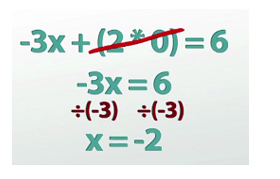Graph for the linear equation y = (3/2)x + 3
'Standard Form' Way to Graph a Linear Equation
So let's take a look at the exact same problem: graph -3x+2y = 6. But this time, try to do it without having to do all those beginning steps where we get y by itself using inverse operations and having to deal with fractions and all that messy stuff.
We know that at the x-intercept, y is 0, and at the y-intercept, x is 0. So because we know this, it turns out that the x and y-intercepts are really easy to find. Check it out; if I know that the x-intercept at y is 0, I can simply substitute 0 in for y into my equation, which gives me -3x+(2*0) = 6.

Well, 2*0 just turns into 0, so this term just cancels out and all that we're left with are the xs, and it's a very simple, quick and easy division to both sides, because division undoes the multiplication of the -3, and we find that x = -2, which is my x-intercept. So I have the coordinates (-2,0).
I can find the y-intercept in exactly the same way. This time, plugging in 0 for x, gives me the equation 2y = 6 because the xs disappear. Again, I simply undo the times by 2 and divide by 2 and I find that y = 3, which gives me the point (0,3). And I have two points and we're done. I can put those two points on my graph - (-2,0), (0,3) - and as long as you have two points, you connect them with your line, and we end up with the exact same line that we did before, but this time we didn't have to solve for y and we didn't have to deal with fractions. It was actually a little bit easier.

Lesson Summary
So to review, we've talked about slope-intercept form and also standard form. We should also probably quickly discuss the pros and cons to each.
Slope-intercept form is a little more intuitive because it gives us more information straight from the rule; it tells us the m and the b that are obvious right from the rule that I can translate quickly into information on the graph.
But standard form is nice if we're trying to find intercepts because it makes it easy to substitute in 0 and solve for the remaining value. So if you're given an equation in standard form and you're asked to graph, there's no reason you really have to change it into slope-intercept form first, and we can use this shortcut of finding the intercepts to do it without having to do all the work of solving for y.